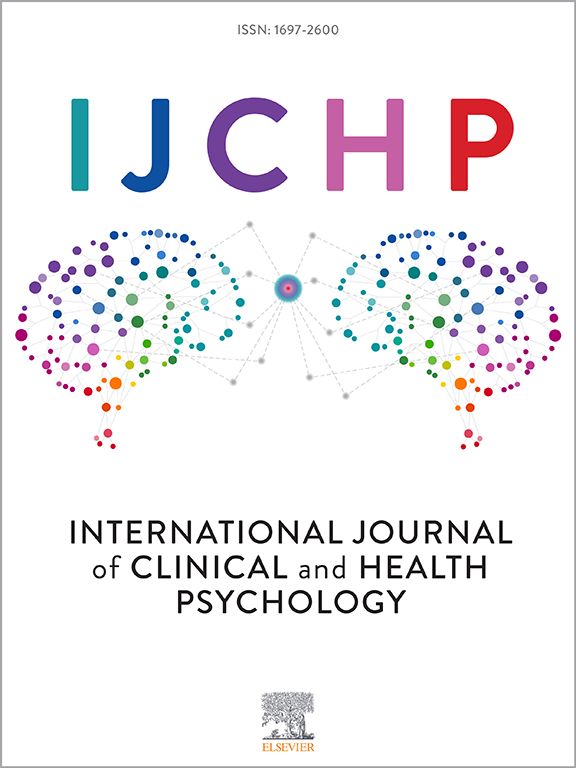Frequency-specific modulations for subcomponents of executive functions in the infra-slow frequency range —A combined O-tDCS and fNIRS study
IF 5.3
1区 心理学
Q1 PSYCHOLOGY, CLINICAL
International Journal of Clinical and Health Psychology
Pub Date : 2025-04-01
DOI:10.1016/j.ijchp.2025.100575
引用次数: 0
Abstract
Backgrounding
The executive functions (EFs) involve multiple subcomponents including inhibition, updating, and shifting. These subcomponents are mediated by distinct brain networks, each linked to specific neural oscillations. Frequency-specific stimulation is a key approach to achieving precise intervention on different cognitive functions through affecting specific spatiotemporal organizations of brain networks.
Objective
We aimed to explore the modulation of different brain networks and EFs’ subcomponents by stimulation at frequencies of 0.02 Hz and 0.05 Hz, which are closely linked to whole-brain dynamics.
Method
In a randomized, placebo-controlled, cross-over study, we applied anodal oscillatory transcranial direct current stimulation (O-tDCS) to the left DLPFC to investigate the frequency-specific modulation on oxy-hemoglobin (HbO) and offline EF scores (Experiment 1, N = 54), as well as online EF scores (Experiment 2, N = 48).
Result
Near the stimulation frequency, brain signals were significantly enhanced. Specifically, an increase in power at 0.02 Hz was associated with enhanced inhibitory function, while an increase in power at 0.05 Hz was linked to decreased updating function. Compared to the sham condition, 0.02 Hz stimulation increases PLV within the frontal lobe, whereas 0.05 Hz increases PLV between the frontal and parietal lobes, indicating the presence of distinct spatiotemporal structures within cognitive-related brain networks.
Conclusion
The frequency-specific modulation of O-tDCS on brain networks and EF subcomponents suggests that different EFs are supported by brain networks with specific spatiotemporal architectures, bolstering the spectral fingerprint hypothesis of cognition. The spatiotemporal structure of cognitive-specific brain networks offers novel insights and targets for non-invasive interventions targeting diverse cognitive functions.
在次慢频范围内执行功能子组件的频率特定调制——O-tDCS和fNIRS的联合研究
执行功能(EFs)涉及多个子组件,包括抑制、更新和转移。这些子成分由不同的大脑网络调节,每个网络都与特定的神经振荡有关。频率特异性刺激是通过影响大脑网络的特定时空组织来实现对不同认知功能的精确干预的关键方法。目的探讨与全脑动力学密切相关的0.02 Hz和0.05 Hz频率刺激对不同脑网络和电磁场子成分的调制作用。方法在一项随机、安慰剂对照、交叉研究中,我们对左DLPFC应用阳极振荡经颅直流电刺激(O-tDCS)来研究频率特异性调节对氧血红蛋白(HbO)和离线EF评分(实验1,N = 54)以及在线EF评分(实验2,N = 48)的影响。结果在刺激频率附近,脑信号明显增强。具体来说,0.02 Hz功率的增加与抑制功能的增强有关,而0.05 Hz功率的增加与更新功能的下降有关。与假刺激相比,0.02 Hz刺激增加了额叶内的PLV,而0.05 Hz刺激增加了额叶和顶叶之间的PLV,这表明在认知相关的大脑网络中存在不同的时空结构。结论O-tDCS对脑网络和EF子成分的频率特异性调制表明,不同的EF受到具有特定时空结构的脑网络的支持,支持了认知的频谱指纹假说。认知特异性脑网络的时空结构为针对不同认知功能的非侵入性干预提供了新的见解和目标。
本文章由计算机程序翻译,如有差异,请以英文原文为准。
求助全文
约1分钟内获得全文
求助全文
来源期刊

International Journal of Clinical and Health Psychology
PSYCHOLOGY, CLINICAL-
CiteScore
10.70
自引率
5.70%
发文量
38
审稿时长
33 days
期刊介绍:
The International Journal of Clinical and Health Psychology is dedicated to publishing manuscripts with a strong emphasis on both basic and applied research, encompassing experimental, clinical, and theoretical contributions that advance the fields of Clinical and Health Psychology. With a focus on four core domains—clinical psychology and psychotherapy, psychopathology, health psychology, and clinical neurosciences—the IJCHP seeks to provide a comprehensive platform for scholarly discourse and innovation. The journal accepts Original Articles (empirical studies) and Review Articles. Manuscripts submitted to IJCHP should be original and not previously published or under consideration elsewhere. All signing authors must unanimously agree on the submitted version of the manuscript. By submitting their work, authors agree to transfer their copyrights to the Journal for the duration of the editorial process.
 求助内容:
求助内容: 应助结果提醒方式:
应助结果提醒方式:


